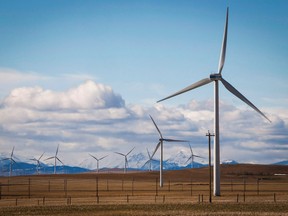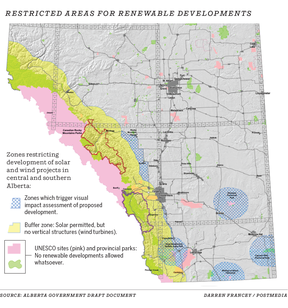Alberta sent a draft map to industry showing where renewable energy projects will and won’t be allowed.

Article content
Large swaths of land near Alberta’s Rocky Mountains and foothills will be off limits for wind energy developments under the province’s new regulations for renewables projects, according to new direction provided by the province.
Alberta sent a draft map on Thursday evening to industry showing where renewable energy projects will and won’t be allowed, which restricts developments in national parks and UNESCO heritage sites, and creates a buffer along the eastern slopes of the Rockies where wind projects would be forbidden.
Advertisement 2
Article content
Article content
It also provides more clarity on the government’s vision for keeping developments away from Alberta’s viewscapes — an area of debate and confusion since announcing in late February 35-kilometre “buffer zones” would be established around protected areas and so-called “pristine viewscapes.”

How is Alberta defining pristine viewscapes?
The Alberta government’s definition for its viewscapes focused heavily on its Rocky Mountains and heritage sites, Nathan Neudorf, Alberta minister of affordability and utilities, said in a Thursday interview.
“Globally, there is no uniform universal definition of pristine land because it differs in every single jurisdiction,” Neudorf said.
“When we talk about our pristine landscapes, I think most people immediately go to Banff and the majestic peaks, and we sought to protect our mountain ranges, our foothills, our UNESCO world heritage sites.”
Under the new regulations outlined in the map, Alberta’s UNESCO heritage sites and national parks will be no-go zones for all renewable developments, Neudorf said. To the edge of the Rockies, the province is implementing a 35-kilometre buffer zone in which no wind projects will be permitted, though solar developments will be allowed.
Article content
Advertisement 3
Article content
Alberta has also created visual impact assessment zones, most of which are isolated to southern Alberta, where all renewable projects proposed in those zones will trigger a review.
None of those zones are expected to affect ongoing oil and gas or forestry activity.
Southern Alberta, where the majority of visual impact assessment zones are, is known for its windy and sunny conditions, making it a hotspot for renewables development.
There are currently several operating wind developments inside the province’s new no-go zone, including a 28-turbine Riverview wind farm and the 76 MW Castle Rock wind project just outside Pincher Creek. TransAlta also has several wind farms in the windy Pincher Creek area. One is its 60-turbine Castle River project.
The province’s map is less restrictive than some had anticipated based off Alberta’s initial signals when it lifted the moratorium on Feb. 28.
Recommended from Editorial
Advertisement 4
Article content
How does industry feel about the new guidelines?
The map marks one step of many to come as the province develops a final framework for renewable projects in Alberta. The province has said the full suite of regulations will take shape by the end of the year.
But the map still leaves several unknowns for industry, said Evan Wilson, vice-president of policy for the Canadian Renewable Energy Association (CanREA).
“I think this provides more clarity on the government’s intent than anything we’ve seen or heard before,” Wilson said. “But there’s still a lot of work that needs to be done to provide clarity for members who are making $100-, $200-, $300-million decisions on projects . . . We need more information than what is provided in a PDF map.”
The lack of rules to date has been criticized for creating uncertainty in the renewables sector. One developer of a solar project up for approval near Pincher Creek said last week it’s moving forward “amid a period of considerable policy and regulatory uncertainty for the renewable sector.”
Jason Schneider, board member at Rural Municipalities of Alberta and reeve of Vulcan County, home to Canada’s largest solar farm, said reaction to the map from his peers in rural Alberta has so far been muted.
Advertisement 5
Article content
“I haven’t heard from any of our members with their hair on fire saying that they’re completely against it,” he said. “Hopefully we can get back to business.”
Releasing the map when the province lifted the moratorium over two weeks ago would have saved a number of headaches, Schneider said, as debates swirled around the province’s definition of viewscapes and protected areas.
Neudorf said the province has been operating “as quick as reasonably possible.”
“We are moving at pace for government, but we don’t want to rush things without trying to take those considerations.”

What’s the expected impact of the new regulations?
With more regulations to be finalized, it’s unclear how the new rules will impact ongoing proposals in Alberta.
The Pembina Institute, a clean energy think tank, has estimated Alberta’s wind regulations would make 22 projects subject to a visual impact assessment or are in a no-go zone. Combined with the draft agricultural restrictions, 57 projects worth $14 billion could be affected, Pembina estimates.
Neudorf said Pembina’s estimates are possible, but developers have shown interest in changing the location or size of their projects.
Advertisement 6
Article content
“That’s kind of the point, is that we didn’t want a free-for-all where we sterilized agricultural land forever,” Neudorf said.
The Alberta Utilities Commission’s (AUC) review of renewable generation in the province, released Wednesday, said Alberta’s existing regulatory framework is “generally sufficient for the protection of environmental land.” It also said that if all renewable development needed to achieve net-zero occurred on prime agricultural land, less than one per cent of Class 2 land would be lost by 2041.
While many of the issues outlined in the AUC report have been ongoing for years, they didn’t justify the six-month moratorium, Wilson said. The report also recommended that if the province implements development no-go viewscape zones, that regulation should be “industry agnostic.”
“I think there’s a lot of misunderstanding around how well regulated the renewable sector is,” Wilson said. “There was no need for a moratorium to have these conversations … This is not the wild west in terms of renewable energy.”
With files from the Canadian Press
Article content






